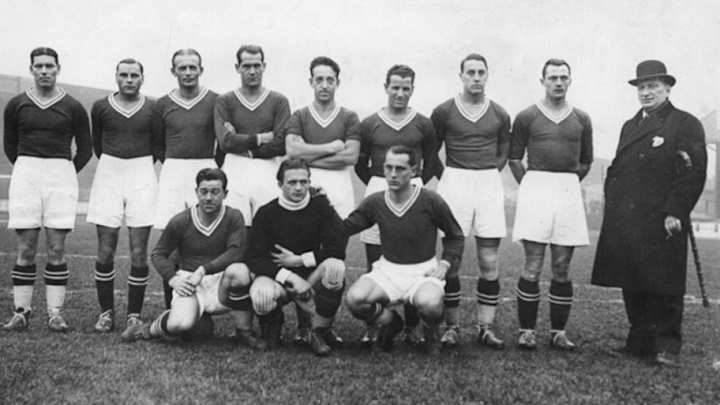World Cup Countdown: 19 Weeks to Go - The 1930's Austrian 'Wunderteam' & the Banker's Son

The Austrian 'Wunderteam' - a team regarded by many footballing historians as the greatest pre-World War II team in Europe.
Masterminded by footballing innovator, Hugo Meisl, they enjoyed a dominant period of superiority across European football in the early 1930s. Playing an entertaining, and highly technical brand of football, their style was revered at a time when the game was undergoing significant change.
It was perhaps no surprise though given the dedication Meisl showed to the sport throughout his life. Operating as general secretary in conjunction with his duties as national head coach, Meisl used his well educated background to help innovate the game.
(You may also be interested in World Cup Countdown: 20 Weeks to Go - Where it All Started, The Story of Uruguay's 1930 Victory)
The son of a banker, he sacrificed a lucrative career following in his father's footsteps to help modernise the government of football, embedding an infrastructure never seen before. Indeed, his team's success was perhaps indebted to the dedication shown by Meisl to improve the standard of football across Europe. Keen to professionalise football, the period became known as a golden era of football as the game was revolutionised.
On March 21, 1927, Meisl drew up the rules for the Mitropa Cup, a precurssor for the modern day Champions League. They included qualification through domestic finish, knock-out home and away ties, with the stipulation that only professional teams could enter. Later that year, Meisl had a helping hand in the creation of the Central Europe International Cup, known in the modern day as the European Championships.
1939 Mitropa Cup, SK Slavia Prague : BSK 2-1 (0:3) #Slavia pic.twitter.com/MHTxg7KFr9
— FootballTime&Nations (@FCTimeNations) January 30, 2018
The creation of the tournaments saw Austrian success follow, as Meisl's players rose to the challenge of the competitive, well-balanced competitions. They were elevated to stardom by the early 1930s, with Meisl's side going on to enjoy an unbeaten run of 14 games, whilst developing a fearsome reputation for entertaining, free-flowing football in the process.
Their key player was centre forward Matthias Sindelar. Nicknamed 'The Mozart of Football', he is recognised as one of the finest pre-war footballers, renowned for his slight build, fantastic dribbling ability and creativity.
Matthias Sindelar. The first false-9 in football history. An integral part of the Austrian Wunderteam of the 30s. pic.twitter.com/bolNF7AOJH
— - (@slothhdad) June 6, 2016
(You may also be interested in 'World Cup Countdown: 19 Weeks to Go - Italy & Mussolini's First International Triumph')
Yet the flamboyant midfielder was cast adrift by staunch disciplinarian Meisl for many years, with the diminutive talent hung out to dry in the international wilderness after a rumoured dispute. Campaigning for his return among commentators and observers led to Sindelar's eventual return to the international fold, four years after his exile.
His return was symbolic, with Sindelar's craft and style complimenting the disciplined, organised and hardworking nature of his teammates. Confident, polished performances had proceeded Sindelar's return in the dismantling of Germany on two separate occasions, but Austria were capable of more. And they delivered more in some style.
“We played football as Jimmy Hogan taught us. When our football history is told, his name should be written in letters”.
Adopting the 'keep it on the carpet' footballing philosophy credited to English friend Jimmy Hogan, Meisl's side combined a quick tempo with a highly skilled, technical style of play. Facing a Scotland side who had yet to be beaten on the continent, the potential metamorphosis of Meisl's side into the 'Wunderteam' was set to be completed.
A 5-0 drubbing ensued, with the magical Sindelar at the forefront of a complete footballing lesson. An 8-1 destruction of Switzerland, and an 8-2 mauling of Hungary were to come as Meisl's team embraced their brand of football like no other team seen before, claiming the 1931 Central Europe International Cup during this dominating period.
History beckoned as Austria entered the 1934 World Cup, staged this time in Italy. Their were many high-profile absentees from the competition's entrants, with reigning champions Uruguay and England among the nations to abstain from participation.
Political turmoil and self imposed exiles aside, Austria had a good chance of winning; more than a good chance in fact. Though perhaps not at their all conquering best, they had demonstrated decent pre-tournament form.
A straight knock-out format awaited, with France the opposition in the first round. An unconvincing 3-2 win after extra-time followed, with a titanic tussle against Hungary awaiting in the quarter final. Goals from Johann Horvath and Karl Zischek saw the Austrians prevail once more, with a narrow 2-1 success in Bologna.
Victory set up a clash with hosts Italy in the ultimate clash of styles - Meisl's side full of grace and elegance, with Vittorio Pozzo's Italian side renowned as a fierce, combative and athletic outfit. Eventually, brawn won out over style, as the Italians won 1-0. Sindelar's threat was nullified by the iconic Luis Monti, as Enrique Guaita prodded home the only goal of a scrappy affair.
#OnThisDay in 1⃣8⃣9⃣5⃣ Willy Meisl was born #SportJournalism #TotalFootball #Wunderteam: https://t.co/jbcdmQjxFs pic.twitter.com/CEpyRbZiNv
— Numero Quattordici (@_Numero14) December 26, 2017
The Austrian dream of winning the World Cup was extinguished, with failure to beat Germany in the third placed playoff seeing their campaign end in abject disappointment, Meisl was perhaps left to wonder what might have been for his prodigal side, who in a three year period between April 1931 and that semi final in June 1934, had lost just three times in 31 games.
They scored 101 goals during that time, and earned the respect of all who went before them. Perhaps one of the greatest sides to never lift the World Cup, the legacy of the 'Wunderteam' will live on forever, with Meisl's side deservedly spoken of in the same breadth as some of football's greatest ever teams.
